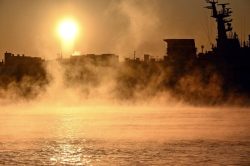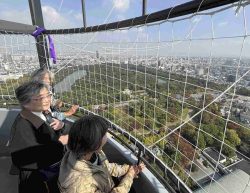
Engineers maintain the Kanmon Bridge with Shimonoseki seen in the background.
11:05 JST, February 4, 2023
SHIMONOSEKI, Yamaguchi — The Kanmon Bridge, which acts as the main artery between two of the nation’s main islands, Honshu and Kyushu, celebrates 50 years of service this year. Not only has it supported domestic logistics and transportation, but it has also served as a symbol of the local community. Currently, the bridge is in the final stages of major renovations that will prepare it for the next 100 years.
Spanning the Kanmon Straits, the 1,068-meter-long bridge opened on Nov. 14, 1973. Serving as a link between the city of Shimonoseki, Yamaguchi Prefecture, and Kitakyushu’s Moji Ward, Fukuoka Prefecture, it was said to be the longest suspension bridge in Asia at that time.

The bridge girders, weighing a total of about 20,000 tons, are supported by a 1,160-meter-long cable, with a diameter of about 66 centimeters. The cable bundles about 14,000 wires together, each 5 millimeters in diameter. If all the wires were connected together, it is said the total length would be equivalent to eight-tenths the circumference of Earth.
Salty air from the sea as well as humidity are the bridge’s greatest adversaries. The inside of the cables and the lower area of the girders facing the sea are prone to corrosion, so essential maintenance continues to be carried out by engineers.
140 meters up
I accompanied engineers who were working on the main tower, which is about 140 meters above sea level. When the tower was completed, two rockets with a thrust of 2 tons were attached to the top horizontally. When the rockets were fired, the force shook the tower, but the bridge remained steady.
Despite that, I was very nervous, feeling weak in my knees. I could see tankers in the channel and trucks and buses coming and going on the bridge’s six-lane road. I could even see the surface of the sea through the wire mesh scaffolding temporarily installed on the cables.

The Kanmon Bridge and the Kanmon Straits are seen in February 2017, with Honshu on the right and Kyushu on the left.
Takuma Morooka, 28, of West Nippon Expressway Co., supervised the work of a contractor who was reapplying preservative paint to parts of cables where the paint had flaked off.
“This kind of low-key but steady work is essential for bridge maintenance,” said Morooka.
The company began repainting work and repairing damaged parts of the bridge in 2011, the first major repair work carried out since it opened. Most of the rusted and dirty parts were repainted, and a drying system was newly installed to reduce the humidity inside the cables to prevent corrosion.
The work is scheduled to be completed in fiscal 2024.
In 2022, the smartNeji system was installed on the underside of the bridge, which lets the company remotely monitor pressure and temperature via sensors, allowing it to prepare for any abnormalities around the clock.
More than 30,000 vehicles cross the bridge every day.
“The bridge not only supports logistics and the flow of people, but also serves as a symbol that makes people feel they have returned to Honshu or crossed over to Kyushu,” said Kazuyuki Motoyama, director of the company’s Kitakyushu expressway office in Kitakyushu, which is in charge of the repair work. “We want to do our best to give the bridge a future.”
Crossing ‘devil’s sea’
The Kanmon Tunnel opened 15 years prior to the bridge’s completion, but traveling by private car through the underwater tunnel was not common. Many locals used ferries to travel back and forth across the Kanmon Straits, which was also known as the “devil’s sea” because of its fast currents.

A ferry cuts across the Kanmon Straits carrying passengers at a time when there was no bridge.
“We would cross the Kanmon Straits with bottles of sake, and drink them all in Moji after a 20-minute boat ride,” recalled Naofusa Mizuno, 88, the chief priest of Akama Shrine, overlooking the straits in Shimonoseki, for about 60 years.
Many of the ferry routes have since been abolished, but the completion of the bridge saw many people from southern Kyushu also come to visit Shimonoseki.
“The Kanmon Bridge is a symbol of Shimonoseki,” said Mizuno. “I hope it will continue to support the city’s economy and tourism.”
Many engineers were involved in the construction of the suspension bridge. However, the unprecedentedly long structure required a lot of trial and error, even with all the talented people available.
Japan’s bridge technology was considered half a century behind that of Europe and the United States in the 1950s, but dramatic advancements were seen upon completion of the Kanmon Bridge.

Girders are being installed during Kanmon Bridge construction in August 1972.
The Japan Highway Public Corporation, now defunct, applied all the latest technologies it had to the bridge, eventually establishing a method of laying cables that would not be affected by weather conditions. These technologies along with human ingenuity honed in the 5½ years leading up to the completion of the bridge were used to construct many other suspension bridges, including some that connect Honshu and Shikoku.
Related Tags
"Features" POPULAR ARTICLE
-

Sanrio to Open Museum in Yamanashi Pref. Dedicated to Founder, Exhibits Include Hello Kitty, Other Characters
-

Autumn Foliage Surrounds Visitors to Tokyo’s Showa Kinen Park
-

My Daughter No Longer Speaks to Me, But I Want to See Her and My Grandchild
-

Kumamoto: Public Bath Refurbished as Library Where You Can Chat, Take Photos
-

Frozen Vegetables: Demand Rises for Convenient, Tasty Domestic Produce
JN ACCESS RANKING
-

Keidanren Chairman Yoshinobu Tsutsui Visits Kashiwazaki-Kariwa Nuclear Power Plant; Inspects New Emergency Safety System
-

Tokyo Economic Security Forum to Hold Inaugural Meeting Amid Tense Global Environment
-

Imports of Rare Earths from China Facing Delays, May Be Caused by Deterioration of Japan-China Relations
-

University of Tokyo Professor Discusses Japanese Economic Security in Interview Ahead of Forum
-

Japan Pulls out of Vietnam Nuclear Project, Complicating Hanoi’s Power Plans

























